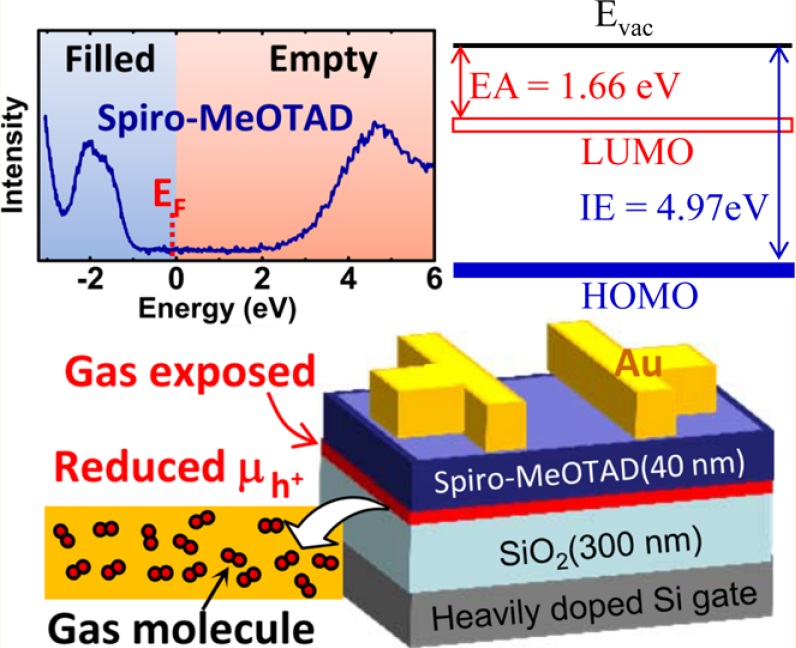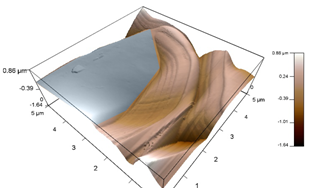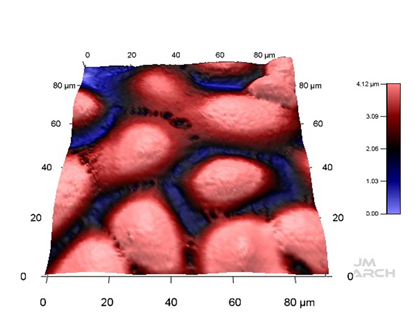FY2013 Annual Report
Energy Materials and Surface Sciences Unit

Abstract
Energy materials are crucial to the near future of the world's technology. Today we still rely on combustion of fossil fuels for energy to drive the growth of society. Two keys to sustained growth are 1) to harvest the energy resources available to us, especially renewable energy sources such as solar power, and 2) to store the energy for convenient and non-intermittent utilization. Advancement of solar power requires reductions in cost that will likely come by introducing organic and/or organic-inorganic hybrid components, as well as understanding and optimization of energy device operations especially at the interfaces. Our Energy Materials and Surface Sciences Unit applies surface science to provide sub-nanometer control over device fabrication as well as understanding of each of the interfaces and how they interact, which can be used as feedback to guide solar cell devices with higher performance.
1. Staff
• Dr. Michael Lee, Group Leader
• Dr. Min-Cherl Jung, Researcher
• Dr. Luis K. Ono, Researcher
• Dr. Gueorgui Nikiforov, Researcher
• Dr. Matthew R. Leyden, Researcher
• Dr. Sonia Ruiz Raga, Researcher
• Dr. Shenghao Wang, Researcher
• Dr. Yuichi Kato, Researcher
• Mr. Zafer Hawash, OIST Graduate Student
• Mr. Thomas Nieddu, OIST Rotation student
• Ms. Yaqiong Li, Research Intern
• Taki Tazuke, Secretary
2. Collaborations
- Air Exposure Induced Gas Molecule Incorporation into Spiro-MeOTAD Films
- Type of collaboration: collaborative research
- Collaborators:
- Professor Antoine Kahn, Princeton University, USA
- Dr. Philip Schulz, Princeton University, USA
- James J. Endres, Princeton University, USA
- Effects of UV ozone and oxygen plasma treatments on transparent flexible electrode
- Type of collaboration: collaborative research
- Collaborators:
- Professor Frederik C. Krebs, Depertment of Energy Conversion and Storage/Technical University of Denmark, Denmark
- Studies on Ant Cuticle
- Type of collaboration: collaborative research
- Collaborators:
- Prof. Evan P. Economo, Mr. Cong Liu, Mr. John Deyrup, Biodiversity and Biocomplexity Unit, OIST
- Nanoparticle-induced plasmonic effects on solar cells
- Type of collaboration: collaborative research
- Collaborators:
- Prof. Mukhles Sowwan, Nanoparticles by Design Unit, OIST
- Morphological and mechanical property evolution of cancer cells
- Type of collaboration: collaborative research
- Collaborators:
- Prof. Tadashi Yamamoto, Dr. Yotaro Shirai, Cell Signal Unit, OIST
3. Activities and Findings
3.1 Air Exposure Induced Gas Molecule Incorporation into Spiro-MeOTAD Films.
L.K. Ono, P. Schulz, J.J. Endres, G.O. Nikiforov, Y. Kato, A. Kahn, and Y. B. Qi*, "Air-Exposure-Induced Gas-Molecule Incorporation into Spiro-MeOTAD Films". J. Phys. Chem. Lett. 5, 1374-1379 (2014).
Combined photoemission and charge transport property studies of the organic hole transport material 2,2’,7,7’-tetrakis(N,N-di-p-methoxyphenylamine)-9,9’- spirobifluorene (spiro-MeOTAD) under air exposure and controlled environments of O2, H2O + N2, and N2 (1 atm and in dark conditions) reveal the incorporation of gas molecules causing a decrease in charge mobility. Ultraviolet photoelectron spectroscopy shows the Fermi level shifts towards the highest occupied molecular orbital of spiro-MeOTAD when exposed to air, O2 and H2O resembling p-type doping. However, no traces of oxidized spiro-MeOTAD+ are observed by X-ray photoelectron spectroscopy (XPS) and UV-visible spectroscopy. The charge transport properties were investigated by fabricating organic field-effect transistors with the 10 nm active layer at the semiconductor-insulator interface exposed to different gases. The hole mobility decreases substantially upon exposure to air, O2, and H2O. In the case of N2, XPS reveals the incorporation of N2 molecules into the film, but the decrease in the hole mobility is much smaller.

Figure 1: Schematic drawing showing the incorporation of gas molecules in the spiro-OMeTAD films leading to reduced mobility.
3.2 Effects of UV ozone and oxygen plasma treatments on transparent flexible electrode.
Y. Kato, M.-C. Jung, M.V. Lee, Y. B. Qi *, "Electrical and optical properties of transparent flexible electrodes: Effects of UV ozone and oxygen plasma treatments". Organic Electronics 15, 721 (2014).
Transparent flexible electrodes are necessary for roll-to-roll processing fabrication, which is a cost-efficient way to make organic electronics such as organic solar cells (OSCs). In order to meet the requirements (e.g. transparency, conductivity, work function, gas-barrier, flexibility, etc.) multi-layer electrodes on a substrate have become active.
“Flextrode” is a flexible transparent electrode consisting of zinc oxide (ZnO)/PEDOT:PSS/silver grid/polyethylene terephthalate fabricated by the roll-to-roll process. The Flextrode provides a ZnO surface on a high-conductivity electrode while maintaining reasonable transparency and good flexibility. It is optimized to be used as the cathode (i.e. low work function) in inverted OSCs. The as-received Flextrode samples have a surface contamination layer that is insulating. Prior to being used in OSCs, this contamination layer need be removed. We applied two surface cleaning methods, i.e., UV-ozone and oxygen plasma, with various treatment times.

Figure 1: In this study, we found that UV-Ozone and O2 plasma treatments can be used to recover the surface properties of "Flextrode".
3.3 Studies on Ant Cuticle.
Ants are generally reddish or black in color. This coloring is similar to some of the most efficient solar cells and suggests and absorption edge between 1-2 electron volts. This is in the range for some of the most efficient single-junction solar cells. The cuticle structure of insects has shown interesting manipulation of optical properties. We expect that the structure of ant cuticle will provide clues for improving solar cell performance.

Figure 1: 3D representation topographical measurement by atomic force microscopy of the cuticle around the acidopore of an ant of the Camponotus Formicinae species. A layered structure of the cuticle is clearly visible in the cuticle platelets surrounding the pore. The high aspect ratio of the cuticle exceeds the dynamic range of the instrument (gray).
3.4 Morphological and mechanical property evolution of cancer cells.
In this study, atomic force microscopy is used to image and probe mechanical properties of cells. Such information is challenging to obtain using other conventional microscopy techniques.

Figure 1: Atomic force microscope 3D image of live HeLa cells.
4. Publications
4.1 Journals
- L.K. Ono, P. Schulz, J.J. Endres, G.O. Nikiforov, Y. Kato, A. Kahn, and Y. B. Qi*, Air-Exposure-Induced Gas-Molecule Incorporation into Spiro-MeOTAD Films. J. Phys. Chem. Lett. 5, 1374-1379 (2014).
- Y. Kato, M.-C. Jung, M.V. Lee, Y. B. Qi *, Organic Electronics 15, 721 (2014)
- Nhu Thuy Ho, V. Senthilkumar, Hak-Soon Cho, Sung Ho Nho, Shinuk Cho, M.-C. Jung*, Y. B. Qi, and Yong Soo Kim, Phyica Status Solidi A, 1-4 (2014)
- Y. M. Lee, D. Ahn, Y. S. Kim, J.-Y. Kim, S. Cho, M. Ahn, M.-H. Cho, M. S. Jung, D. K. Choi, M.-C. Jung* and Y. B. Qi, Scientific Reports, 4, 4702 (2014)
- Y. M. Lee, J. Baik, H. -J. Shin, Y. S. Kim, S. G. Yoon, M. -C. Jung* and Y. B. Qi, Applied Surface Science, 292, 986 (2014)
4.2 Books and Other One-Time Publications
nothing to report
4.3 Oral and Poster Presentations
- Yabing Qi, “Structure-property relationships in organic thin films”, invited talk at Nanjing University, China, May 3, 2013.
- Yabing Qi, “Influences of Substrate Temperature on Organic Film Growth”, invited talk at the first Asian conference for “MONODUKURI” Strategy by Synthetic Organic Chemistry (ACMS), Okinawa, Japan, July 17-19, 2013.
- Yabing Qi, “Organic Thin Film Growth: Effects of Substrate Temperature and Surface Modification”, oral presentation at the 2013 JSAP-MRS Joint Symposia, Doshisha University, Kyoto, Japan, September 16-20, 2013.
- Yabing Qi, “Structure-property relationship of organic films”, poster presentation at the CEMS international workshop, University of Tokyo, Tokyo, Japan, December 15-17, 2013.
- Yabing Qi, “Gas-exposure effects on electronic properties of a hole transporting material”, invited talk at RIKEN, Japan, December 18, 2013.
- Yabing Qi, “Low-cost solar cells”, invited talk at the Joint ISSP-OIST Symposium: Lighting Up New Frontiers – From Tokyo to Okinawa, From Materials to Neurons, Okinawa, Japan, March 10, 2014.
- Min-Cherl Jung, Matthew Leyden, Gueorgui Nikiforov, Michael V. Lee, Han-Koo Lee, Tae Joo Shin, Kazuo Takimiya and Yabing Qi*, MRS2014 Spring Meeting, San Francisco, USA
- Min-Cherl Jung, Matthew Leyden, Gueorgui Nikiforov, Michael V. Lee, Han-Koo Lee, Tae Joo Shin, Kazuo Takimiya and Yabing Qi*, Novel Quantum Materials and Phases (NQMP2014), Okinawa, Japan
- L.K. Ono, “Air Exposure Induced Oxidation of Doped Spiro-MeOTAD Based Hole Transport Layer: Implications on Perovskite Solar Cell Devices.”, 2014 MRS Spring Meeting & Exhibit, San Francisco, California, April 21-25, 2014.
5. Intellectual Property Rights and Other Specific Achievements
Nothing to report
6. Meetings and Events
6.1 Seminar
- Date: June 13, 2013
- Venue: OIST Campus Lab1, D015
- Speaker: Prof. David Cahen, Weizmann Institute of Science, Israel
- Title: Energy THE global challenge
- Date: June 13, 2013
- Venue: OIST Campus Lab1, C016
- Speaker: Prof. David Cahen, Weizmann Institute of Science, Israel
- Proteins as Electronic "Dopable" Materials
- Date: June 14, 2013
- Venue: OIST Campus Lab1, C015
- Speaker: Prof. David Cahen, Weizmann Institute of Science, Israel
- Photovoltaic Solar Cells: What determines their Efficiency?
- Date: July 29, 2013
- Venue: OIST Campus Lab1, C016
- Speaker: Dr.Tae Joo Shin, PAL, POSTECH, Korea
- Characterization of Organic Thin Films by Synchrotron Grazing-incidence X-ray Diffraction
- Date: July 29, 2013
- Venue: OIST Campus Lab1, C016
- Speaker: Dr.Han-Koo Lee, PAL, POSTECH, Korea
- Electronic and Structural properties of organic films using Near edge X-ray absorption fine structure spectroscopy
- Date: January 3, 2014
- Venue: OIST Campus Lab1, C016
- Speaker: Derek K. Toomre, PhD, Director of the YALE 'CINEMA' Laboratory, New Haven, Connecticut, USA.
- Title: Nanoscopy of cellular dynamics
- Date: January 4, 2014
- Venue: OIST Campus Lab1, C016
- Speaker: Derek K. Toomre, PhD, Director of the YALE 'CINEMA' Laboratory, New Haven, Connecticut, USA.
- Title: Seeing and controlling membrane traffic with optogenetics



